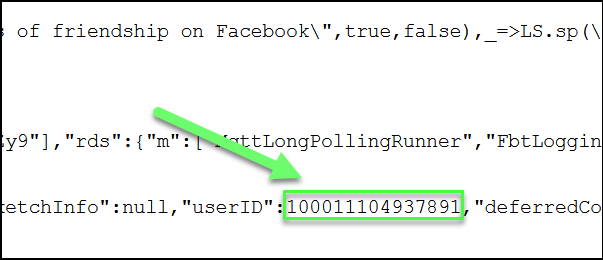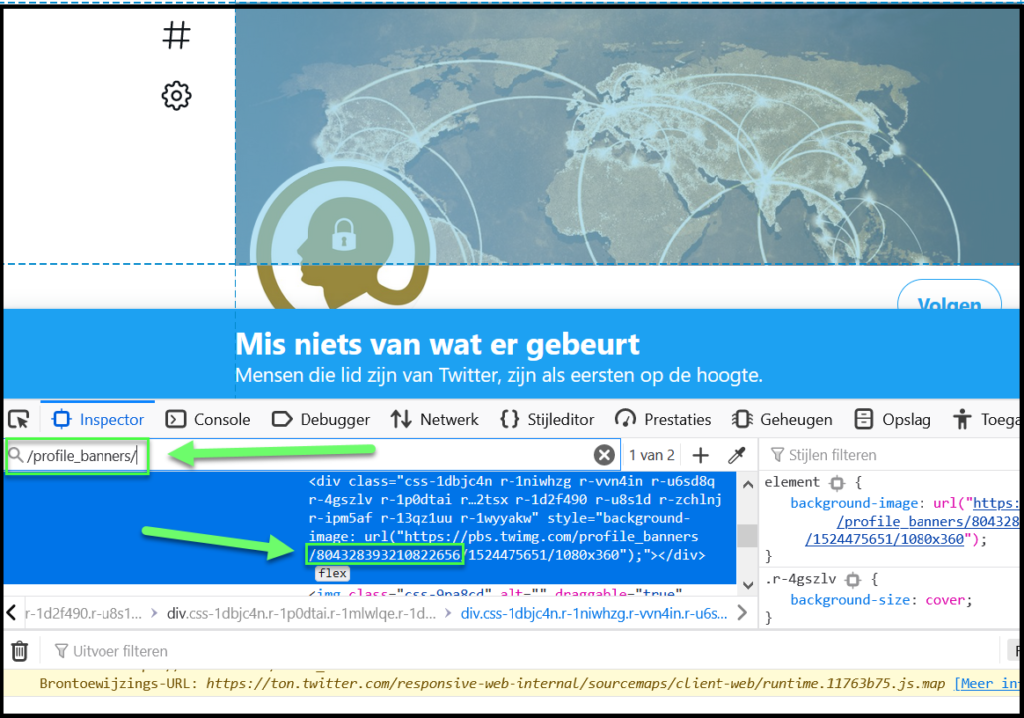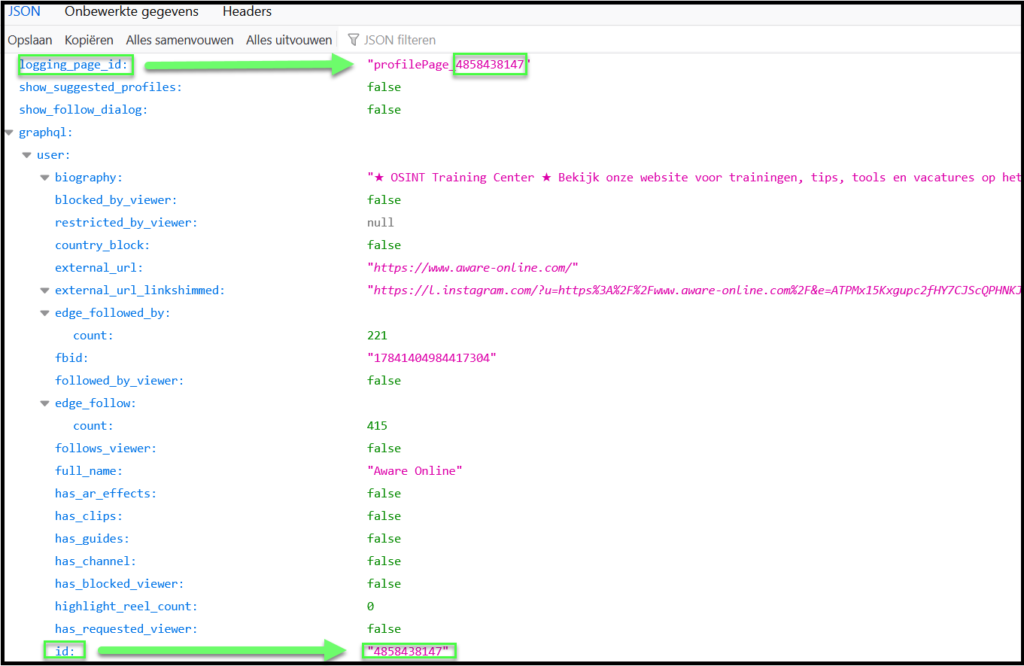
The importance of user identification numbers (IDs) in social media investigations
In this blog post, we explain what user identification numbers (IDs) are and what the importance of user IDs are for investigations on social media. We will show how to find IDs of users on Facebook, Twitter and Instagram and we will explain how you can convert user IDs back to user accounts.
What are user identification numbers (ID’s)?
Social media platforms such as Facebook, Twitter and Instagram use user identification numbers (ID’s) to store user profiles in their databases. Such identification numbers or ID’s cannot be traced back to real persons, but they are linked to profiles of users on the platforms. In addition to profiles, pages, locations, groups and events can also have identification numbers, as is the case with Facebook. It is important to remember that identification numbers are unique and cannot be changed. Thus, an ID can only be associated with one user and this user cannot change his or her ID.
The importance of user ID’s in investigations
In your investigations on social media, it may be important to record the ID’s of users. We have already mentioned the main reason why user ID’s are important: This is because user ID’s are unique and non-changeable: you can continue to track profiles based on their ID’s, which would be more difficult if you did that based on the name or username of an account. Another reason to record user ID’s is that you can use user ID’s in law enforcement online requests, which you can read more about at the bottom of this article.

Names on social media
The image above is a screenshot of Aware Online’s Twitter profile. On this Twitter profile you will see that the name of our account is “Aware Online“. This name has been chosen by ourselves and we can change this name if we wish. The name of an account on Twitter therefore is changeable, which makes it difficult to track an account based on the name of the account. In addition, the name of our account does not have to be unique: other users can use exactly the same name as our account. This too can make tracking an account based on the name of the account difficult.
Usernames on social media
Usernames or handles on social media are, unlike “names“, unique. That means there can only be one account on a social media platform that uses a specific username or handle. For example, on Twitter there is only one user with the username “aware_online” and that is us. Tracking an account based on a username seems to be a better solution than following an account based on the name of an account. There is one thing, however, and that is that users can change their username. Usernames on social media are therefore changeable, which can still make it more difficult to track an account based on a username.
Identification numbers (ID’s) on social media
Where names and usernames can be hard to track on social media, identification numbers (ID’s) are easier to follow. On social media, these IDs are unique and unchangeable. There is only one user who uses the ID “804328393210822656” (our account on Twitter) and we do not have the option to change this ID. We could only create a new account to obtain a new ID. For this reason, tracking an account based on an identification number (ID) is a better solution than tracking an account based on an account name or username.
How to find user ID’s on social media
Below we explain how to find out the identification numbers of users on Facebook, Twitter and Instagram. Of course there are various tools on the internet that will make the following easier for you. However, we teach our students to be able to manually find the IDs of social media accounts. We don’t want our students to be dependent off third-party tools, we don’t want them to leave unwanted traces and we do want them to know exactly what they are doing.
How to find an user ID on Facebook
Step 1: log in to Facebook with your sock puppet account. You cannot retrieve user IDs without logging in.
Step 2: navtigate to the Facebook profile you wish to investigate. In this example we use the account about our Dutch prime minister https://www.facebook.com/markrutte.
Step 3: click on an empty part of the page (not on an image or on a link) with your right mouse button on “View page source“.
Step 4: search the source code for the identification number directly after “userID:“. We recommend that you use the find function to search for this piece of text within the source code*. You access the find function by typing the CTRL + F keys simultaneously on your Windows keyboard. The number sequence that you will see next is the identification number (ID) of the user. See below an example of the ID “100011104937891” of the user with the username “markrutte“.
*: Can’t find this section? Or are you seeing strange results? Then this is probably because you are using the Mozilla Firefox web browser. For example, use the web browser Google Chrome or click through the search results in Firefox a number of times until you have found the right piece of text.

Step 5: do not retype the ID, but copy the ID to avoid errors and check that you have copied the correct ID. To do this, open www.facebook.com and paste “/100011104937891” directly after the URL. So the full URL you get iswww.facebook.com/100011104937891. Does this URL lead to the profile with the username “markrutte“? Then you have found the right profile.
How to find an user ID on Twitter
Step 1: navigate to the Twitter profile you wish to investigate. In this example we use our Twitter account https://twitter.com/aware_online.
Step 2: right click on “Inspect Element” or click the F12 key on your keyboard. Step 3: make sure the “Inspector” tab is selected as shown in the example below.

Step 4: type the keywords “profile_banner” as shown in the example below. You will see that the Twitter profile cover photo is selected with this. You will also see two series of numbers in the blue shaded area at the bottom behind the section “https://pbs.twimg.com/profile_banners/“. The first string of numbers, the “804328393210822656” section, is the ID of the Twitter profile with the username “aware_online“.

Step 5: check that the ID is the correct ID by logging in to Twitter and navigating to the following link: https://twitter.com/i/connect_people?user_id=804328393210822656 (enter the ID of the account you are investigating here). If the account you are investigating appears at the top (see the example below), you know you have found the correct ID. Note: Do not click the “Follow” button as your Twitter account will start following the account you are investigating.
How to find an user ID on Instagram
Step 1: navigate to the Instagram account you wish to investigate. In this example we use our Instagram account https://instagramcom/aware_online.
Step 2: directly after the URL “www.instagram.com“, typ the part “/? __ a = 1” to get the following URL: https://www.instagram.com/aware_online/?__a=1. You will now see all kinds of data in Javascript Object Notation (JSON). Note: if you open the page with the web browser Google Chrome, you will only see the raw data. We therefore recommend using the Mozilla Firefox web browser because this web browser automatically converts the raw data into JSON format.
Step 3: after the “logging_page_id” or the “id” value, read the identification number (ID) of the account you are investigating. In the example below, this is the ID “4858438147“. Of course there are also other ways to find this ID!

Step 4: check if the ID you found is correct by navigating to https://i.instagram.com/api/v1/users/4858438147/info/ and by replacing the ID with your target ID. You will see the error notification “useragent mismatch“. This means that you are not using the correct user agent to get back results from Instagram’s web server.
Step 5: install a browser extension to spoof your user agent. In this example we use the “User-Agent Switcher and Manager” for the web browser Mozilla Firefox. This browser extension can be found here: https://addons.mozilla.org/nl/firefox/addon/user-agent-string-switcher/.
Step 6: look for a user agent suitable for Instagram. On the website https://developers.whatismybrowser.com/useragents/explore/software_name/instagram/ multiple suitable Instagram user agents are presented. In this example we will use the useragent string “Mozilla/5.0 (Linux; Android 9; SM-A102U Build/PPR1.180610.011; wv) AppleWebKit/537.36 (KHTML, like Gecko) Version/4.0 Chrome/74.0.3729.136 Mobile Safari/537.36 Instagram 155.0.0.37.107 Android (28/9; 320dpi; 720×1468; samsung; SM-A102U; a10e; exynos7885; en_US; 239490550)“.
Step 7: copy the useragent string and paste it at the heading “userAgent” in your browser extension. Then click on “Apply (container)“.
Step 8: after the heading “username:” read the username of the profile to which the identification number is linked (ID). Note: Do not forget to reset the settings of your user agent spoofer! Otherwise, your web browser will continuously use Instagram’s user agent, which can cause problems when investigating other websites and social media profiles.
Law enforcement online requests
If you want to make an law enforcement online request to Facebook or Instagram, you can do so via the following link:https://www.facebook.com/records/login/. And for Twitter use this link: https://legalrequests.twitter.com/forms/landing_disclaimer. These procedures allow you to make online request to Facebook, Instagram and Twitter in order to disclose certain information about specific users. You can use the identification number (ID) of the relevant user for this. Please note that you must be a law enforcement officer to initiate these procedures. Facebook, Instagram and Twitter are also not obliged to release information, so these procedures do not concern formal claims.
Can we help you?
In this blog post, we have explained to you the importance of identification numbers (ID’s) in your investigations on social media. Because identification numbers are unique and non-changeable, you can use them to track users on social media platforms. We showed you how to find out the identification numbers of users on Facebook, Twitter and Instagram and how to convert identification numbers back to user profiles. Would you like to receive more information? Or can we provide you with support in your investigation? Please contact us or register for one of our OSINT-training events.





10 Comments